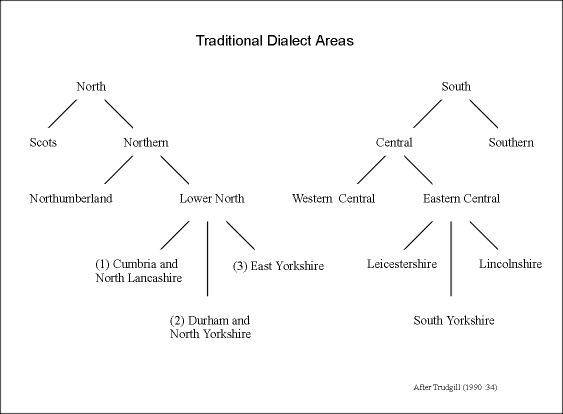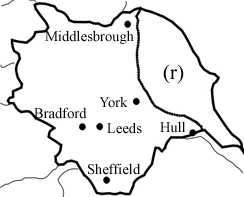

 |
 |
According to Trudgill (1990), England is broken down into thirteen Traditional Dialect (henceforth TD) areas, groupings being made on the basis of similarities and differences in speech. The major demarcation within these groups is the North / South divide which runs from the Lancashire coast across to the Humber, approximately following the line of the old Anglo-Saxon border between the ancient kingdoms of Mercia and Northumbria. As can be seen from the dialect tree below, North and East Yorkshire fall within the Northern dialect group (specifically the Lower North) whilst South Yorkshire is part of the Southern group (in effect, part of the Eastern Central area).
 |
The differences and similarities in speech characteristics mentioned above relate to the pronunciation of eight words. The following is a comparison between the pronunciation of the North and East Ridings (NER) and those of the West Riding (WR). Throughout these pages a double consonant following a vowel is indicative of the shortening of that vowel.
| Standard English | long | night | blind | land | arm | hill | seven | bat |
| NER | lang | neet | blinnd | land | ahm | 'ill | seven | bat |
| WR | long | neet | blinnd | land | ahm | 'ill | seven | bat |
Trudgill (1990) observes that, in TD, such words as long, wrong, strong, etc are pronounced with a short <a> instead of an <o>, (i.e. Lang, wrang, strang, etc.) and that find, blind, etc. are realized with a short <i> (finnd, blinnd, etc.). Such pronunciations, he says, link back to the original Anglo-Saxon realizations . Similarly, the employment of a monophthong (i.e. a pure vowel) by Northern speakers in such words as house, out, and cow (i.e. hoos, oot and coo) is the retention of the original medieval pronunciation. Trudgill further observes that, in some areas of the North, a modified version of the Anglo-Saxon long <a> is preserved in such words as home and stone, their pronunciations being hee-am and stee-an. Likewise, spoon, fool, etc. are realized as spee-oon, fee-ool, and so on. For further details of the historical perspective see The Historical Development of Yorkshire Dialect
Other important features of dialect, especially in relation to Yorkshire, are: -ing which is pronounced as -in' (e.g. walkin', talkin', etc.); the use of the short <a> (as in cat) in words like bath and dance; and the dropping of word-initial <h> (e.g. 'appy, 'orrible, etc.).
The following is a guide provided by Kellett (1992) regarding Yorkshire pronunciation as represented by his spelling convention (also employed in the sections devoted to lexis and grammar).
Vowels
| a | usually short as in crash. Kellett notes that some older dialect speakers employ this sound after w in words like wasp and swan |
| ah | as in cart |
| e | as in bed |
| ee | as in feel |
| i | as in bit |
| o | as in pot |
| aw | as in saw |
| u | as in foot |
| oo | as in gloom |
Kellett (1992) also remarks on the fact that the er sound is modified so that thirst, for example, becomes thust or thost.
Diphthongs
| aa | thus naame (roughly nay-em) for name |
| ooa | (roughly oo-er) so that words such as floor, door and afore become flooar, dooar and afooar |
| ow | as in browt, owt and nowt (i.e. brought, anything and nothing). The realization of this sound is not equivalent to the Standard English pronunciation of now but more like aw-oo |
| oi | used in such WR words as coit, throit and 'oil (i.e. coat, throat and hole) |
| eea | appears in words like again, death and street (pronounced ageean, deeath and streeat) |
Consonants
Kellett (1992) suggests that consonants in Yorkshire dialect are pronounced more emphatically than in Standard English.
The glottal stop
Kellett observes that <t> is often replaced by a glottal stop which provides such renderings as :
| ge' i' e'en (i.e. gerr it etten) |
| get it eaten |
Variations in Yorkshire Phonology
Vowels, diphthongs etc.
Kellett (1992) points out that most sounds in 'broad' Yorkshire are common to all three Ridings but that, in terms of specific vowels and diphthongs, there are major differences. He provides the following examples (double consonants indicate the shortening of the preceding vowel).
| Standard English | West Riding | East Riding | North Riding |
| About | abaht | aboot | aboot |
| Down | dahn | doon | doon |
| House | 'ahse | 'oose | 'oose |
| Boot | booit | beeat | beeat |
| Fool | fooil | feeal | feeal |
| Door | dooar | deear | dooar |
| Floor | flooar | fleear | flooar |
| Speak | speyk | speeak | speeak |
| Coal | coil | cooal | cooal |
| Home | 'ooam | 'eeam, 'ooam or yam | 'eeam, 'ooam or yam |
| Father | fatther | feyther or faather | feyther or faather |
Consonants.
In relation to the realization of consonants, none of the literature suggests a marked differentiation between the three Ridings. There are however two exceptions: the degree of rhoticity (the sounding of <r> after a vowel), and the devoicing of voiced consonants.
 After Trudgill (1990) |
With regard to the first, Trudgill (1990: 25-6) claims that, in East Yorkshire (see map) there is 'partial retention' (i.e. the <r> is sounded in certain words or positions but not in others) in such words as arm. He further notes that <r> is also retained after what he calls 'the er vowel' occurring in words like bird and first (1990: 25-6; 39). Relative to word-final <r>, as in words like four, star and better, French (1986) observes that, although not pronounced in 'standard accents' for at least three hundred years, this feature is still extant in the Malton district (notably an area spanning both the North and East Ridings). He noted that there was a distinct tendency, in the speech of some retired agricultural workers, to pronounce word-final <r>, especially where the word preceded a short pause (for example, double click here). French concludes that this was interpreted as a signal that, although the speaker would be hesitating, he nevertheless intended to continue speaking (1986: 30-1).
The second exception is associated with the WR dialect (although it does occur throughout an area reaching beyond York) and relates to the devoicing of voiced consonants (b, d, g, etc) when they occur immediately before their voiceless counterparts(p, t, k, etc.). For example, red tin is pronounced as ret tin (Trudgill 1990: 67-8). An example of such devoicing can be heard by single clicking here. Note that the realization of "the pig couldn't ...." sounds like "the pick couldn't....".
Sources
French, P. with Miller, S. Cade, V. and Hunt, C. (1986) Documenting Language Change in East Yorkshire. In Transactions of the Yorkshire Dialect Society, Vol. XVI, Part LXXXVI.
Kellett, A. (1992) Basic Broad Yorkshire, Revised Edition, Otley: Smith Settle.
Trudgill, P.(1990) The Dialects of England, Oxford: Blackwell.